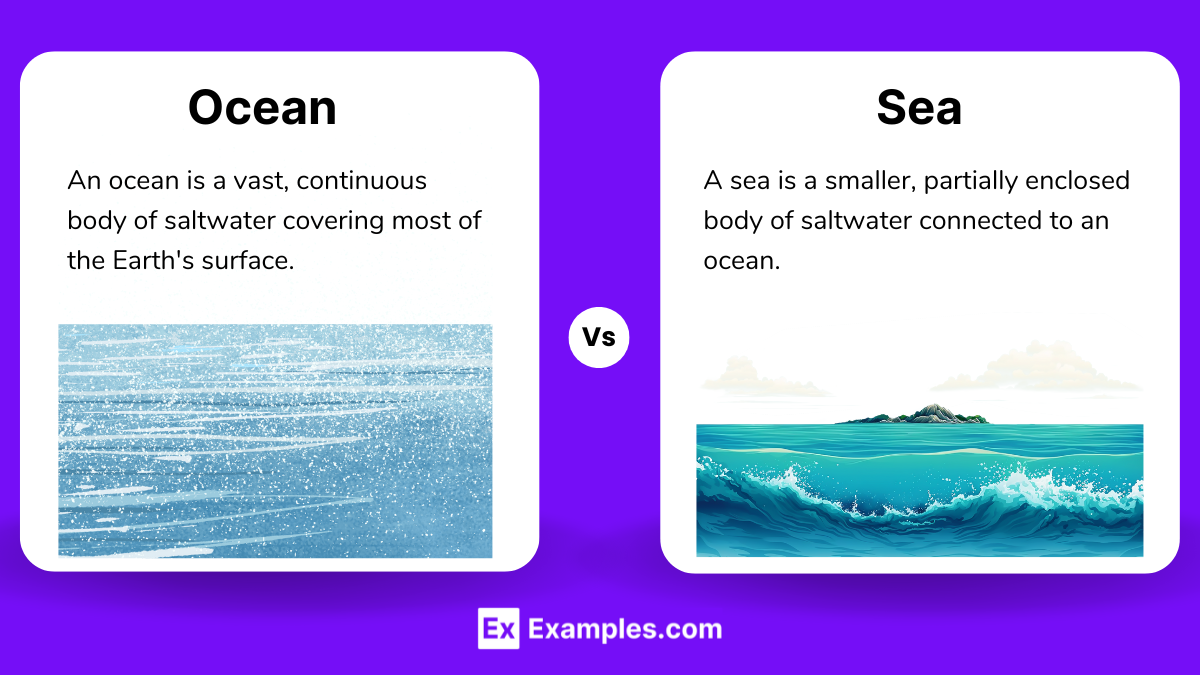Which is larger in size?
Ocean
Sea
Lake
River


When we look at a world map, we see vast bodies of water covering a significant portion of the Earth’s surface. These bodies of water, known as oceans and seas, play a crucial role in our planet’s climate, ecosystems, and human activities. However, many people use the terms “ocean” and “sea” interchangeably, not realizing that these water bodies have distinct characteristics. This article will explore the key differences between oceans and seas, shedding light on their unique features, sizes, depths, and ecological significance. By understanding these differences, we can better appreciate the diverse and dynamic nature of Earth’s aquatic environments.
An ocean is a vast and continuous body of saltwater that covers over 70% of the Earth’s surface. Oceans are the largest and deepest parts of the hydrosphere and play a vital role in regulating the planet’s climate and weather patterns. There are five main oceans on Earth: the Pacific, Atlantic, Indian, Southern, and Arctic Oceans.
A sea is a smaller body of saltwater that is partially enclosed by land and often connected to an ocean. Seas are found on the margins of the oceans and are usually located where the land meets the ocean. They are smaller and shallower than oceans and often have more direct interactions with coastal environments and human activities.
| Point of Comparison | Ocean | Sea |
|---|---|---|
| Definition | Vast, continuous bodies of saltwater covering larger areas. | Smaller bodies of saltwater partially enclosed by land. |
| Size | Larger, covering millions of square kilometers. | Smaller, covering thousands to hundreds of thousands of square kilometers. |
| Depth | Generally deeper, with average depths around 3,700 meters. | Shallower, with average depths around 200 meters. |
| Location | Found between continents and surrounding islands. | Located at the edges of oceans, often near coastlines. |
| Number | Five major oceans: Pacific, Atlantic, Indian, Southern, and Arctic. | Dozens of seas, including the Mediterranean, Caribbean, and South China Sea. |
| Marine Life | Supports diverse and abundant marine life, including large species like whales and sharks. | Also supports diverse marine life but often with different species adapted to specific conditions. |
| Currents | Characterized by large, powerful currents like the Gulf Stream. | Currents are generally smaller and less powerful. |
| Salinity | Generally uniform salinity levels throughout. | Salinity can vary more due to freshwater input from rivers and restricted circulation. |
| Formation | Formed by tectonic activity and the movement of Earth’s plates. | Often formed by geological processes like the submergence of land or tectonic activity. |
| Climate Influence | Major influence on global climate and weather patterns. | Influence regional climates but to a lesser extent than oceans. |
| Human Impact | Less directly affected by human activities but impacted by pollution and climate change. | More directly affected by human activities such as fishing, shipping, and coastal development. |
| Examples | Pacific Ocean, Atlantic Ocean, Indian Ocean. | Mediterranean Sea, Red Sea, Baltic Sea. |
Oceans and seas have many similarities as they are both large bodies of saltwater and play crucial roles in Earth’s ecosystem. Here are some key similarities between oceans and seas:
Oceans are vast, deep, and cover larger areas, while seas are smaller, shallower, and often partially enclosed by land.
There are five oceans: the Atlantic, Pacific, Indian, Southern, and Arctic.
There are over 50 seas globally, including the Mediterranean, Caribbean, and Baltic seas.
Oceans are significantly larger than seas, covering about 71% of Earth’s surface.
Yes, seas are typically smaller subdivisions of oceans and are often located where land and ocean meet.
While both host diverse marine life, oceans have a wider range due to their size and depth.
Yes, some seas, like the Caspian Sea, are entirely surrounded by land.
The Pacific Ocean is the deepest, with the Mariana Trench reaching about 36,000 feet.
The Philippine Sea is the largest, covering around 5 million square kilometers.
Oceans generally have higher salinity due to greater evaporation rates and less freshwater influx compared to seas.
Text prompt
Add Tone
10 Examples of Public speaking
20 Examples of Gas lighting
Which is larger in size?
Ocean
Sea
Lake
River
Which of the following is typically found at the edges of continents?
Ocean
Sea
Desert
Mountain
The Mediterranean is an example of a:
Ocean
Sea
Gulf
Bay
How many major oceans are there on Earth?
2
1
5
10
Which of these is the smallest ocean?
Pacific
Atlantic
Indian
Arctic
Which term describes a large body of saltwater that is smaller than an ocean and partly enclosed by land?
Lake
Sea
River
Pond
What is the primary difference between an ocean and a sea?
Salinity
Temperature
Size and location
Depth
Which ocean is the deepest?
Atlantic
Pacific
Indian
Arctic
The Red Sea is connected to which ocean?
Pacific
Atlantic
Indian
Arctic
What separates the Southern Ocean from the Atlantic, Pacific, and Indian Oceans?
Equator
Prime Meridian
International Date Line
Antarctic Convergence
Before you leave, take our quick quiz to enhance your learning!

